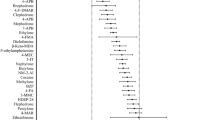Abstract.
We studied whether serotonin release in the CNS is inhibited via cannabinoid receptors. In mouse brain cortex slices preincubated with [3H]serotonin and superfused with medium containing indalpine and metitepine, tritium overflow was evoked either electrically (3 Hz) or by introduction of Ca2+ (1.3 mM) into Ca2+-free K+-rich (25 mM) medium containing tetrodotoxin. The effects of cannabinoid receptor ligands on the electrically evoked tritium overflow from mouse brain cortex slices preincubated with [3H]choline and on the binding of [3H]WIN 55,212–2 and [35S]GTPγS to mouse brain cortex membranes were examined as well.
In superfused mouse cortex membranes preincubated with [3H]serotonin, the electrically evoked tritium overflow was inhibited by the cannabinoid receptor agonist WIN 55,212–2 (maximum effect of 20%, obtained at 1 µM; pEC50=7.11) and this effect was counteracted by the CB1 receptor antagonist SR 141716 (apparent pA2=8.02), which did not affect the evoked tritium overflow by itself. The effect of WIN 55,212–2 was not shared by its enantiomer WIN 55,212–3 but was mimicked by another cannabinoid receptor agonist, CP-55,940. WIN 55,212–2 also inhibited the Ca2+-evoked tritium overflow and this effect was antagonized by SR 141716. Concentrations of histamine, prostaglandin E2 and neuropeptide Y, causing the maximum effect at their respective receptors, inhibited the electrically evoked tritium overflow by 33, 69 and 73%, respectively. WIN 55,212–2 (1 µM) inhibited the electrically evoked tritium overflow from mouse brain cortex slices preincubated with [3H]choline by 49%. [3H]WIN 55,212–2 binding to mouse cortex membranes was inhibited by CP-55,940, SR 141716 and WIN 55,212–2 (pKi=9.30, 8.70 and 8.19, respectively) but not by the auxiliary drugs indalpine, metitepine and tetrodotoxin (pKi<4.5). [35S]GTPγS binding was increased by WIN 55,212–2 (maximum effect of 80%, pEC50=6.94) but not affected by WIN 55,212–3.
In conclusion, serotonin release in the mouse brain cortex is inhibited via CB1 receptors, which may be located presynaptically and are not activated by endogenous cannabinoids. The extent of inhibition is smaller than that obtained (1) via another three presynaptic receptors on serotoninergic neurones and (2) via CB1 receptors on cholinergic neurones in the same tissue.
Similar content being viewed by others
Author information
Authors and Affiliations
Additional information
Electronic Publication
Rights and permissions
About this article
Cite this article
Nakazi, M., Bauer, U., Nickel, T. et al. Inhibition of serotonin release in the mouse brain via presynaptic cannabinoid CB1 receptors. Naunyn-Schmiedeberg's Arch Pharmacol 361, 19–24 (2000). https://doi.org/10.1007/s002109900147
Received:
Accepted:
Issue Date:
DOI: https://doi.org/10.1007/s002109900147




